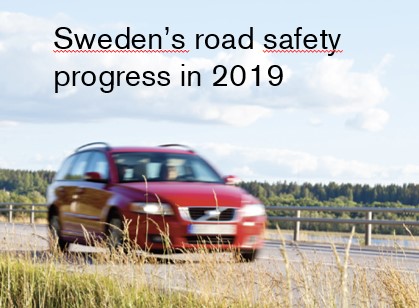The result of the traffic safety work in Sweden 2019: It is possible to get close to zero fatalities
Today, April 16, the Swedish Transport Administration held its annual conference to present Sweden's results in its work to reduce the number of fatalities and seriously injured in road traffic. The number of people affected has decreased and the assessment is that with joint forces it is possible to get close to zero, or at least reach an acceptable level of risk.
In 2019, 223 people died in Sweden’s transport system, that was less than in 2018 when 324 people lost their lives.
A positive trend, but complex relationship
It is very difficult to explain what it is that makes the result vary so much between the years, it is probably a combination of coincidence and the complex relationships that exist between the indicators and the external factors.
“When we are down to such low figures, we also know that there is a high likelihood that the number of fatalities varies between individual years. It is important that we see the development over time and are persistent in our efforts to achieve Vision Zero - that no one should die or be seriously injured in traffic”, says Maria Krafft, Safety director at the Swedish Transport Administration and member of SAFER’s Board.
When it comes to the number of seriously injured, there is a clear downward trend that is even better than the annual target plan. About 3800 people were seriously injured in 2019, which of course still is too many.
The development of the indicators
There are also a number of separate indicators that are followed up on an annual basis. The results of these do not fully align with the set goals, but still follow a positive long term trend. In 2019, only the safety belt usage and the indicator for safe passenger cars reached their annual targets.
The speed limit on both state and municipal roads is still kept poorly, but speeding has been somewhat reduced. Keeping the right speed is a key factor in reducing the number of traffic accidents and it is recommended that those who buy transport services include speed limit requirements in their procurement and follow up on compliance. Of course, the social norm also plays a part. If everyone in the traffic system kept the speed limit, close to 100 lives per year could be saved. Unfortunately, alcohol and drugs continue to be involved in many deaths, albeit the figures are relatively constant. In 2019, 53 of the traffic deaths were alcohol related.
For unprotected road users, we unfortunately do not see an equally positive trend and the number of seriously injured has not decreased. Of those seriously injured, almost half of these are cyclists. One reason is the low helmet use. The target is a helmet use rate of 70%, but only 47% of the cyclists use helmet according to the statistics in 2019. A change of attitudes and norms as well as more information about the benefits of a bicycle helmet could contribute to a more positive development. Road maintenance has also been prioritized lower in several municipalities, which has been a contributing factor for not decreasing the accidents according to plan.
The number of fatalities in passenger cars continues to decline sharply. The number has decreased by almost 40% and the number of injured is fairly stable around 1000 people per year. However, fatalities in heavy vehicles and especially light trucks have increased significantly.
New stage target set
Sweden has recently decided on a new target where the number of road fatalities between 2020 and 2030 should decrease by 50% and seriously injured is to be reduced by 25%.
“It's just for us to continue to work towards the new target; in SAFER's case we will contribute with research that provide the society with new knowledge to help develop sustainable and safe vehicle and traffic safety solutions”, Magnus Granström, Director at SAFER, says.
Sweden has come a long way in its work to achieve vision zero, although it is obviously not acceptable that someone is killed in the transport system. Perhaps it may be worth looking at what is an acceptable level of risk, a golden standard, in the same way as we do in aviation.
Many measures are underway that offer opportunities to save more lives in traffic
Road safety is an interaction between infrastructure measures, vehicle crash safety and road user behaviour. We need to continue to utilise new technology. For example, connected vehicles, sensors that help understand the road environment and vehicles that automatically brake for unprotected road users can save many lives both in urban areas and on national roads. About 7-8 percent of the car park is replaced every year, which has an effect on road safety and saves 7-9 lives per year.
A long-term measure for increased road safety is to build meeting-separated roads that prevent frontal collisions. But we also need to implement measures that have a faster effect on road safety, such as the continued establishment of road safety cameras and adjustments of speed limits, based on the design of the roads.
The result report of Sweden’s road safety progress is produced by the Swedish Transport Administration, the Swedish Transport Agency and Swedish National Road and Transport Research Institute (VTI). The complete result report will be published 5 May, 2020.


